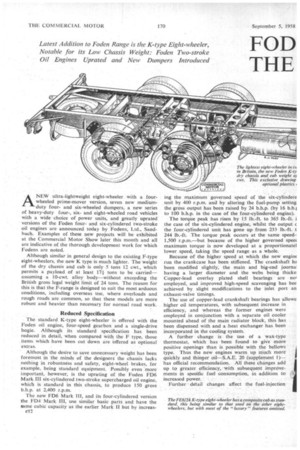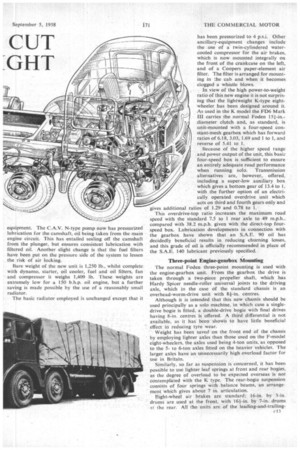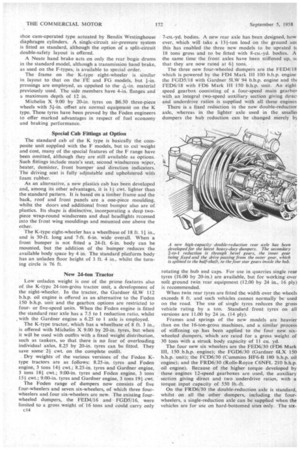FOD THE
Page 50

Page 51

Page 52

Page 53

If you've noticed an error in this article please click here to report it so we can fix it.
Latest Addition to Foden Range is the K-type Eight-wheeler, Notable for its Low Chassis Weight: Foden Two-stroke Oil Engines Uprated and New Dumpers Introduced
ANEW ultra-lightweight eight-wheeler with a fourwheeled prime-mover version, seven new mediumduty fourand six-wheeled dumpers, a new series of heavy-duty four-, sixand eight-wheeled road vehicles with a wide choice of power units, and greatly uprated . versions of the Foden fourand six-cylindered two-stroke oil engines are announced today by Fodens, Ltd., Sandbach. Examples of these new projects will be exhibited at the Commercial Motor Show later this month and all are indicative of the thorough development work for which Fodens are noted.
Although similar in general design to the existing F-type eight-wheelers, the new K type is much lighter. The.weight of the dry chassis and cab is only 5 tons 12 cwt., which permits a payload of at least 17i tons to be carried— assuming a 10-cwt, alloy body—without .exceeding the British gross legal weight limit of 24 tons. The reason for this is that the F-range is designed to suit the most arduous conditions, including overseas use, where overloads and rough roads are common, so that these models are more robust and heavier than necessary for normal road work.
Reduced Specification
The standard K-type eight-wheeler is offered with the Foden oil engine, four-speed gearbox and a single-drive bogie. Although its standard specification has been reduced in detail, when compared with the F type, those items which have been cut down are offered as optional extras.
Although the desire to save unnecessary weight has been foremost in the minds of the designers the chassis lacks nothing in robustness and safety, eight-wheel brakes, for example, being standard equipment. Possibly even more important, however, is the uprating of the Foden FD6 Mark III six-cylindered two-stroke supercharged oil engine, which is standard in this chassis, to produce 150 gross b.h.p. at 2,400 r.p.m.
The new FD6 Mark III, and its four-cylindered version the FD4 Mark III, use similar basic parts and have the same cubic capacity as the earlier Mark II but by increas c12 log the maximum governed speed of the six-cylindere unit by 400 r.p.m. and by altering the fuel-pump setting the gross output has been raised by 24 b.h.p. (by 16 b.h.i to 100 b.h.p. in the case of the four-cylindered engine).
The torque peak has risen by 15 lb.-ft. to 365 lb.-ft. i the case of the six-cylindered engine, whilst the output c the four-cylindered unit has gone up from 233 lb.-ft. t 244 lb.-ft. The torque peak occurs at the same speed-. 1,500 r.p.m.—but because of the higher governed speec maximum torque is now developed at a proportionate] lower speed, taking the speed range as a whole.
Because of the higher speed at which the new engin( run the crankcase has been stiffened. The crankshaft ha been modified slightly, the main and big-end journa' having a larger diameter and the webs being thicke Copper-lead overlay plated shell bearings are no, employed, and improved high-speed scavenging has bee achieved by slight modifications to the inlet port an exhaust-valve timings.
The use of copper-lead crankshaft bearings has allowe higher oil temperatures, with subsequent increase in efficiency, and whereas the former engines were employed in conjunction with a separate oil cooler mounted ahead of the main radiator block, this has been dispensed with and a heat exchanger has been incorporated in the cooling system.
A further change is the use of a wax-type thermostat, which has been found to give more positive openings than is possible with the bellows type. Thus the new engines warm up much more quickly and thinner oil—S.A.E. 20 (supplement 1)—
has official recommendation. All these changes add up to greater efficiency, with subsequent improvements in specific fuel consumption, in addition to increased power.
Further detail changes affect the fuel-injection equipment. The C.A.V. N-type pump now has pressurized lubrication for the camshaft, oil being taken from the main engine circuit. This has entailed sealing off the camshaft from the plunger, but ensures consistent lubrication with filtered oil. Another slight change is that the fuel filters have been put on the pressure side of the system to lessen the risk of air locking.
Bare weight of the new unit is 1,250 lb., whilst complete with dynamo, starter, oil cooler, fuel and oil filters, fan and compressor it weighs 1,409 lb. These weights are extremely low for a 150 b.h.p. oil engine, but a further saving is made possible by the use of a reasonably small radiator.
The basic radiator employed is unchanged except that it has been pressurized to 4 p.s.i. Other ancillary-equipment changes include the use of a twin-cylindered watercooled compressor for the air brakes, which is now mounted integrally on the front of the crankcase on the left, and of a Coopers paper-element air filter. The filter is arranged for mounting in the cab and when it becomes clogged a whistle blows.
In view of the high power-to-weight ratio of this new engine it is not surprising that the lightweight K-type eightwheeler has been designed around it. As used in the K model the FD6 Mark III carries the normal Foden l5-in.diameter clutch and, as standard, is unit-mounted with a four-speed constant-mesh gearbox which has forward ratios of 6.18, 3.03, 1.69 and Ito 1, and reverse of 5.41 to 1.
Because of the higher speed range and power output of the unit, this basic four-speed box is sufficient to ensure an entirely adequate road performance when running solo. Transmission alternatives are, however, offered, including a super-low auxiliary box which gives a bottom gear of 13.4 to 1, with the further option of an electrically operated overdrive unit which acts on third and fourth gears only and gives additional ratios of 1.29 and 0.78 to 1.
This overdrive-top ratio increases the maximum road speed with the standard 7.5 to 1 rear axle to 49 m.p.h., compared with 38.2 m.p.h. given with the direct-top fourspeed box. Lubrication developments in connection with the gearbox have shown that an S.A.E. 90 oil has decidedly beneficial results in reducing churning losses, and this grade of oil is officially recommended in place of the S.A.E. 140 lubricant previously specified.
Three-point Engine-gearbox Mounting
The normal Foden three-point mounting is used with the engine-gearbox unit. From the gearbox the drive is taken through a two-piece propeller shaft, which has Hardy Spicer needle-roller universal joints to the driving axle, which in the case Of the standard chassis is an overhead-worm-drive unit with 81-in. centres.
Although it is intended that this new chassis should be used principally as a solo machine, in which ease a singledrive bogie is fitted, a double-drive bogie with final drives having 8-in, centres is offered. A third differential is not available, as it has been shown to have little beneficial effect in reducing tyre wear.
Weight has been saved on the front end of the chassis by employing lighter axles than those used on the F=model eight-wheelers, the axles used being 4-ton units, as opposed to the 5to 6-ton axles fitted on the heavier vehicles. The larger axles have an unnecessarily high overload factor for use in Britain.
Similarly, so far as suspension is concerned, it has been possible to use lighter leaf springs at front and rear bogies, as the degree of overload to be expected overseas is not contemplated with the K type. The rear-bogie suspension consists of four springs with balance beams, an arrangement which gives about 7 in. articulation.
Eight-wheel air brakes are standard: 16-in. by 3-in. drums are used at the front, with 164--in. by 7-in, drums at the rear. All the units are Of the leading-and-trailing shoe cam-operated type actuated by Benclix Westinghouse diaphragm cylinders. A single-circuit air-pressure system is fitted as standard, although the option of a split-circuit double-safety layout is offered.
A Neate hand brake acts on only the rear bogie drums in the standard model, although a transmission hand brake, as used on the F-types, is available to special order.
The frame on the K-type eight-wheeler is similar in layout to that on the .FE and FG models, but 1-in. pressings are employed, as oppo'sed to the h-in. material previously used. The side members have 4-in, flanges and a maximum depth of 12 in.
Michelin X 9.00 by 20-in. tyres on B6.50 three-piece wheels with 5f-in, offset are normal equipment on the K type. These tyres have been proved by the Foden engineers to offer marked advantages in respect of fuel economy and braking performance.
Special Cab Fittings at Option
The standard cab of the K type is basically the composite unit supplied with the F models, but to cut weight and cost, many of the special features of the F range have been omitted, although they are still available as options. Such fittings include mate's seat, second windscreen wiper, heater, demister, front bumper and direction indicators. The driving seat is fully adjustable and upholstered with foam rubber.
As an alternative, a new plastics cab has been developed and, among its other advantages, it is 11 cwt. lighter than the standard pattern. It is based on a timber frame and the back, roof and front panels are a one-piece moulding, whilst the doors and additional front bumper also are of plastics. Its shape is distinctive, incorporating a deep two-. piece wrap-round windscreen and dual headlights recessed into the front wing mouldings and mounted one above the other.
The K-type eight-wheeler has a wheelbase of 18 ft. 11 in., and is 30-ft. long and 7-ft. 6-in, wide overall. When a front bumper is not fitted a 24-ft. 6-in, body can be mounted, but the addition of the bumper reduces the available body space by 4 in. The standard platform body has an unladen floor height of 3 ft. 4 in., whilst the turning circle is 76 ft.
New 24-ton Tractor
Low unladen weight is one of the prime features also of_ the K-type 24-ton-gross tractor unit, a development of the eight-wheeler. in the tractor, the Gardner 6LW 112 b.h.p. oil engine is offered as an alternative to the Foden 150 b.h.p. unit and the gearbox options are restricted to fouror five-speed units. When the Foden engine is fitted the standard rear axle has a 7.5 to I reduction ratio, whilst with the Gardner engine a 6.25 to 1 axle is employed.
The K-type tractor, which has a wheelbase of 8 ft. 3 in., is offered with Michelin X 9.00 by 20-in. tyres, but when it will be used with outfits with a fixed weight distribution, such as tankers, so that there is no fear of overloading individual axles, 8.25 by 20-in. tyres can be fitted. They save some 21 cwt, on the complete outfit.
Dry weights of the various versions of the Foden Ktype tractors are as follows: 8.25-in. tyres and Foden engine, 3 tons 141 cwt.; -8.25-in. tyres and Gardner engine, 3 tons 181 cwt.; 9.00-in. tyres and Foden engine, 3 tons
151 cwt.; 9.00-in. tyres and Gardner engine, 3 tons 191 cwt.
The Foden range of dumpers now consists of five four-wheelers and seven six-wheelers, of which three fourwheelers and four six-wheelers are new. The existing fourwheeled dumpers, the FED4/16 and • FGD5/16, were limited to a gross weight of 16 tons and could carry only
c14
7-cu.-yd. bodies. A new rear axle has been designed, how ever,. which will take a 131-ton load on the ground ant this has enabled the three new models to be uprated ti 18 tons gross and to be fitted with 8-cu.-yd. bodies. A the same time the front axles have been stiffened up, a that they are now rated at 61 tons.
The three new four-wheeled dumpers are the FED4/18 which is powered by the FD4 Mark III 100 b.h.p. engine the FGD5/18 with Gardner 5LW 94 b.h.p. engine and th( FED6/18 with FD6 Mark III 150 b.h.p. unit. An eight. speed gearbox consisting of a four-speed main gearbo) with an integral two-speed auxiliary section giving direci and underdrive ratios is supplied with all these engines There is a fixed reduction in the new double-reductior axle, whereas in the lighter axle used in the smallei dumpers the hub reduction can be changed merely b3 rotating the hub end caps. For use in quarries single rear tyres (16.00 by 20-in.) are available, but for working over soft ground twin rear equipment (12.00 by 24 in., 16 ply) is recommended.
When twin rear tyres are fitted the width over the wheels exceeds 8 ft. and such vehicles cannot normally be used on the road. The use of single tyres reduces the gross vehicle rating by a ton. Standard front tyres on all versions are 11.00 by 24 in. (14 ply).
Frames and springs of the new models are heavier than on the 16-ton-gross machines, and a similar process of stiffening up has been applied to the four new sixwheeled dumpers, which are rated for a gross weight of 30 tons with a struck body capacity of 11 cu. yd.
The four new six wheelers are the FED6/30 (FD6 Mark HI, 150 b.h.p. engine); the FGD6/30 (Gardner 6LX 150 b.h.p. unit); the FCD6/30 (Cummins HF6-B 180 b.h.p. oil engine); and the FRD6/30 (Rolls-Royce C6NFL 210 b.h.p. oil engine). Because of the higher torque developed by these engines 12-speed gearboxes are used, the auxiliary section giving direct and two underdrive ratios, with a torque input capacity of 550 lb.-ft.
On the FRD6/30 the double-reduction axle is standard, whilst on all the other dumpers, including the fourwheelers, a single-reduction axle can be supplied when the vehicles are for usc on hard-bottomed sites only. The six wheeled dumpers have four-spring bogies and power steering is optional. All the new six-wheelers weigh approximately 12+ tons, permitting a payload of 17+ tons, 'whilst the new four-wheelers weigh 7+ tons, giving a payload capacity of 10-1 tons.
The new special heavy-duty range of road vehicles has been developed primarily to meet export requirements, although all the chassis are available on the home market. The standard F-type four-, six and eight-wheelers are affected, and the principal departure from the standard
F specifications is that Gardner 6LX, Rolls-Royce C6NFL, Cummins HF6-B 180 b.h.p. or NHB-6 210 b.h.p. oil engines are offered.
Four-wheelers with standard axles are rated for a solo gross weight of 14 tons, or 25 tons gross train weight, but these and the standard F types can be fitted with 6-ton front axles and 12-ton rear axles, which raise the solo weight to 18 tons. The standard gearboX on any of the four-wheelers is either the 12-speed unit or the new fivespeed close-ratio box. The former is recommended for heavy duty, but the five-speed box is suitable for trunk services in Great Britain.
Similar specification changes apply to the heavy-duty six-wheelers, which, like the standard F types are rated for
21 tons gross solo, with 33 tons gross train weight. As
with the four-wheelers, however, heavy-duty front and rear axles can be fitted, in which case the solo gross weight rating is 30 tons. In the case of the eight-wheelers with the heavy-duty axles the solo weight rating can be increased from the standard 24 tons to 36 tons, the gross train weight being the same in each Case-33 tons.
On all these heavy-duty vehicles, double-reduction axles can be fitted. When they are used in a single-drive bogie,
gross train weights up to 70 tons are permitted, whilst the double-drive double-reduction bogies allow a gross train weight of 100 tons on special tractors. The ordirtaty double drive single reduction bogie, whilst permitting up to 33 tons gross train weight for normal highway application, is suitable up to 50 tons gross train weight when operating in flat country_




































































































